Feather Barbels Catfish (Ossancora punctata)
| Feather Barbels Catfish Ossancora punctata | |
|---|---|
| Name | Feather Barbels Catfish |
| Name Lat. | Ossancora punctata |
| Synonym | Doras punctatus |
| Family | Thorny Catfishes |
| Family lat. | Doradidae |
| Order | Catfishes |
| Order lat. | Siluriformes |
| Origin | South America |
| Habitat | Rivers |
| Diet | Omnivore |
| pH | 5.8-7.5 |
| Behavior | Nocturnal, peaceful |
| Keeping | Group |
| Care Level | Easy |
| Reproduction | Oviparous |
| Breeding | None reported |
| Life Span | 8-12 years |
| Protection | No |
| Metric Units | |
| Size | 10-12 cm |
| Temperature | 20-27 °C |
| Hardness | 5-15 °dH |
| Aquarium | ~ 200 l |
| US Units | |
| Size | 3.9"-4.7" |
| Temperature | 68-81 °F |
| Hardness | 89-267 ppm |
| Aquarium | ~ 50 gal |
Distribution and habitat
Featherbeard spiny catfishes are widespread in the Amazon River basin, from Peru to Brazil to Paraguay and Argentina. They live in shoals in stagnant or slow-flowing waters with dense underwater vegetation as well as in floodplains, where they usually stay hidden under plants and roots during the day.
Maintenance
The aquarium should have dense planting, with plenty of hiding places, such as stone caves (e.g. perforated rock) and roots, as well as some free sandy areas. A sandy substrate covered with some foliage (e.g. sea almond leaves) and subdued light (e.g. floating plant cover) and slightly acidic water is ideal
No ammonia, ammonium and nitrite should be detectable, the nitrate value should not exceed 100 mg/l. To ensure the water quality and oxygen content, a filter and heater adapted to the aquarium size is required, as well as lighting for the species-appropriate day-night rhythm of the animals.
Diet
They are problem-free in feeding. The food supply consists of live food, such as daphnia, artemia, mysis, mosquito larvae, etc., which is also eaten frozen without problems or a commercial frozen food mix, supplemented with some vegetable food such as algae leaves. Sinking dry food for catfish (pellets, granules, tablets) is also well accepted
Only as much should be fed as is eaten overnight. A regular and varied diet promotes health and prevents deficiency symptoms
Behaviour and compatibility
These lively crepuscular to nocturnal fish are very peaceful and should be kept in a group of at least 5. Keeping a group is only recommended in a larger and well structured aquarium. They can be socialized well with other calm and peaceful fish. Basically, only compatible fish species with similar demands on water quality and water temperature should be socialized.
Sex dimorphism
The sexes are difficult to distinguish. The females are slightly larger and appear more rounded than the slimmer males
Reproduction and breeding
There are no known reports of successful breeding in the aquarium.
Important
They rummage through the substrate in search of food
With their shoulder girdle they can produce creaking sounds.
When catching them, use fine-meshed nets if possible; transparent cups are better so that the hard rays (with barbs) of the pectoral and dorsal fins do not get caught, which can cause painful stinging injuries when touched
The well-being of the fish should be checked regularly. Temperature should be checked daily, pH, hardness and nitrate levels at least every 14 days. Regular partial water changes are recommended, even when contaminant levels have not yet reached the upper limit. Sudden changes in water quality should be avoided. Newly introduced fish must be accustomed slowly to the water in the aquarium.
Further literature can be found in your pet store.
References
Text: petdata; Image: Franz Lowak
Source: BMELV (1998): Tierschutzgutachten - Haltung von Zierfischen (Süßwasser); ENGELMANN (2005): Zootierhaltung - Tiere in menschlicher Obhut: Fische, Verlag Harri Deutsch
- Gemäß § 21 Abs. 5 Tierschutzgesetz idgF
